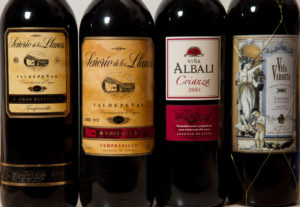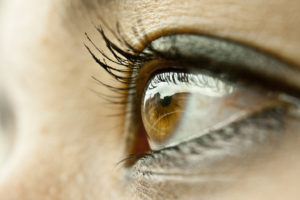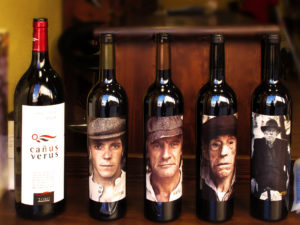With countless bottles to choose from while shopping for wine, and without the ability of the winery to have their products sampled prior to purchase (most of the time anyway), the label

Photo courtesy Keith Williamson
on the bottle is the last hurrah, if you will, for a winery to maximize their chances of their bottles being the chosen ones. What should a winery put on that label to get someone to buy it? A flashy label? A wordy story? The decision to what the label should look like can arguably be just as important as the growing of the grape and other winemaking processes prior to the wine even going into the bottle.
The label must be attractive enough to catch someone’s attention and to keep that gaze long enough to create a conscious or subconscious attachment and preference on the part of the consumer. While wine purchase decisions vary among individuals, it is often the beginners or wine novices that most use the label itself as a crucial factor in this decision.
General consumer studies have shown that a persons’ gaze can both reflect and bias purchase decisions. In other words, by looking at a wine label, gaze can tell a lot about how someone feels about it as well as their likelihood of purchasing that bottle. Known as the “gaze cascade effect”, the longer someone looks at a label, the more cognitive processing occurs and subconscious preferences are developed. By having an attractive label that draws the eye would likely then improve the chances of that wine being purchased, based on the theories behind the gaze cascade effect.
To date, most research on wine selection (or retail in general) is based upon questionnaires and surveys. While these approaches only consider conscious decision-making processes, the world of subconscious influence on purchases decisions is relatively unknown. We might say in a survey that we’d purchase a bottle of wine based upon x, y, and z, is that how we’d behave when faced with the actual decision to buy a bottle of wine?
One way to approach this question of how our subconscious behaviors influence our purchase decisions is by using eye-tracking technologies. Briefly, eye-tracking technology can monitor several physiological responses of the eye when presented with visual stimuli in real-time, thus allowing the researcher to determine how much they are “paying attention” to that stimuli and relating that to the final purchase decision made by that individual.
A study published last year in the International Journal of Wine Business Research, aimed to use eye-tracking technology to evaluate wine purchase behaviors solely based upon subconscious responses to a group of wine labels. Additionally, alternative labels to the labels that were subsequently chosen by the winemakers were presented, to evaluate if the right label was chosen for maximizing the chances of being purchased.
Brief Methods
Experiment 1

Photo courtesy Flickr user Sergio Fabara Muñoz
For the first part of the study, the relationship between gaze and preference was evaluated.
18 people from the University of Oslo (Norway) participated in this study (11 females, 7 males). All participants were considered alcohol drinkers, though they claimed to be wine novices.
A Remote Eye Tracking Device was used to track and analyze eye movement data.
Images for 8 different wine brands were shown in this part of the study. Each brand was represented by 4 label images: 1 that was the chosen label by the winemaker to be placed on the bottles for actual sale, and 3 that were in the running but didn’t make the final cut. Each set of 4 images were shown 4 times but in different label order, so that every label would be seen on every position on the “shelf”.
Participants viewed each batch of labels for 10 seconds. After this time, another image of wine bottles with only “A”, “B”, “C”, and “D” as labels were presented and participants were asked to choose with of the labels from the previous image was their preferred label.
Experiment 2
This part of the experiment examined wine label attractiveness and how this attractiveness related to willingness to pay (or estimated price) for a given bottle of wine.
Part A
40 participants from the University of Oslo (Norway) participated in this part of the study (20 females, 20 males). Again, all claimed to be wine novices.
Images for 10 different wine brands (4 labels per brand) were shown in this part of the study.
Participants were asked to rate the attractiveness of each wine label (later extrapolated to a 1-10 scale).
Average attractiveness was separated into four categories: low, medium low, medium high, and high.
Part B
49 participants from the University of Oslo (Norway) participated in this part of the study (25 females, 24 males). Again, all claimed to be wine novices.
The wine label images used were the same as they were in Part A. This part of the study also utilized the Remote Eye Tracking Device to measure pupil dilation.
The instructions for the participants were to imagine they were in the store to buy some wine, and to indicate the price they would be willing to pay for each of the wine labels shown. Each label was then shown for 10 seconds and afterwards participants were to indicate the price they would be willing to pay for a bottle with that label.
Selected Results
Experiment 1
- The greater the preference for the label, the longer the gaze upon that label was.
- Bottle position influence gaze time:
- More time was spent on the bottle just left of center in the group of 4 than any other position.
- The bottle on the far-right side of the group of 4 received the shortest gaze.
- Average preference was distributed equally across all 4 positions, despite the position preference mentioned above.
- Since the labels were shown in all 4 positions, this result indicates that label alone can trump position on the shelf.
- There was a tendency for participants to prefer the “real” label as opposed to the other three labels that didn’t make the winemaker’s cut for final label choice, BUT this tendency was NOT SIGNFICANT.
- Pictorial elements on the label took up the vast majority of time during a gaze, with only 2% of the time allocated to text elements like varietal, brand name, etc.
- Pictorial elements were gazed at longer for “real” labels than the labels that didn’t make the final cut.
Experiment 2
Part A
- There were significant differences in attractiveness between wine labels of different brands.
- There were NO differences in attractiveness between “real” labels and labels that did not make the final cut for a given brand.
Part B
- There was a significant association between attractiveness and average price estimate.
- As label attractiveness increased, the estimate price of the bottle also increased.
- There was a significant association between pupil changes and label attractiveness.
- This relationship followed a U-shape: the pupils were dilated the greatest for the least attractive labels and the most attractive labels.
- When the wines were sorted by actual market prices (during the analysis phase of the study), researchers found that labels of more expensive wines caused greater pupil dilation than labels of less expensive wines. (NOTE: participants had no prior knowledge to the actual prices of these wines).
Conclusions
Using eye-tracking technology to determine purchase preferences for wine bottles in this study offers some interesting results:
Experiment 1:
First, results showed that the longer a participant gazed at a wine label, the greater the preference for that label was developed. In other words, staring at it longer increases the chances that an individual will prefer and ultimately purchase that bottle.
In terms of bottle position on the shelf, while the bottle just left of center stole the most glances, bottle position itself did not influence final preference, indicating that the label itself will trump whatever spot it’s placed on the shelf (at least in a line of 4 anyway).
In terms of WHAT people are actually looking at, it seems that picture elements take up the vast majority of the time spent looking at the label, with only 2% of that time being dedicated to text elements like brand name, varietal, etc. This could be explained by the fact that reading in an automatic behavior that is completed in a very short period of time by the brain. Perhaps it’s not that the participants don’t care about the text, it’s just that their brains can process and be finished with it much faster than something that is pictorial in nature.
Finally, in terms of the “real” labels versus the labels that didn’t make the winemaker’s final cut, the results from this experiment were relatively inconclusive. While the researchers said there was a tendency for participants to prefer the “real” labels, this tendency was not significant and can’t be ruled out as better than chance alone. Interestingly, participants did spend longer times looking at the pictorial elements of the “real” labels compared with the ones that didn’t make the final cut, so perhaps design elements of the “real” labels were more complex and therefore needed more time to process than the other labels.

Photo courtesy Flickr user jacinta lluch valero
Experiment 2 (both Parts A and B):
First, results showed that label attractiveness predicted estimated price of the wine bottle. In other words, the more attractive participants thought a label was, the higher the price they associated with that bottle.
When pupil behavior was examined, the researchers saw a U-shape response, meaning that pupils were dilated the greatest both at the lowest level of attractiveness and the highest level of attractiveness for the wine labels of study. What this basically means is that pupil dilation can’t predict the absolute attractiveness of a wine label, it can indicate the intensity of response. In other words, if someone’s pupil is dilated to the max while looking at a label, one can determine that is it either incredibly beautiful, or the ugliest thing they have ever seen.
Finally, when the researchers sorted the bottles by actual market prices (after the experiment was over), they found that pupil dilation was positively associated with market price of the bottles. In other words, the more expensive a given bottle was, the more a participants’ pupils would dilate as they observed the label of that bottle. So, subconsciously, you can pick out the most expensive wine in the bunch simply by looking at the label and observing how wide your pupils dilate. I can only assume that the more expensive bottles are from wineries that can afford good graphic designers.
Wrapping in up…
In general, whenever I see a form of technology not used often (or at all) in wine research being used for the first time, I think it’s really cool. This study is no different. Using eye-tracking technology to determine wine selection preferences shows promise as a marketing research technique, though according to the researchers would need to be used in conjunction with other methods.
It is important to note that the participants of this study were all considered to be wine novices, so the results cannot be extrapolated to any other group (like wine experts, etc). It would be really interesting to see a comparative study examining these same eye-tracking properties in groups of varying levels of wine expertise.
Overall, the study found that the longer someone looked at a label, the greater the chance that individual would prefer (and potentially purchase) that bottle of wine. So, the key here would be to design a label that grabs and keeps the consumer long enough to burn a proverbial hole in their mind so they are thus bias and can’t forget it. Exactly HOW to design that label was beyond the scope of this study and would require further research.
Source:
